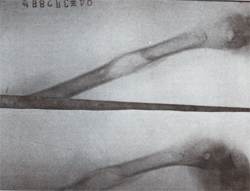Traditional Chinese medicine treatment for bone cysts, symptoms of bone cysts, jawbone cysts, no incision, no surgery!
1. **Bone Cysts**: Subcategories include aneurysmal bone cysts, epithelioid bone cysts, subchondral bone cysts of joints, and juxta-articular bone cysts, etc.
2. **Causes of Bone Cysts**:
- (1) Most scholars believe it is related to trauma.
- (2) Some consider it as the result of degenerative changes in certain tumors or inflammatory tissues, and metabolic disorders during growth.
- (3) In adults, bone cysts may be associated with the liquefaction and necrosis of some tumors.
- (4) Some believe it is related to abnormal bone development.
3. **Incidence and Location of Bone Cysts**:
- The incidence rate is higher in males than in females, with a ratio of about 2.5:1. The age of onset ranges from 4 to 42 years old, with an average of 16 years. A small number of cases occur within two months after birth and over 50 years old. About 80% of patients are children and adolescents under 20 years old. It commonly occurs in long tubular bones, especially in the upper part of the humerus, accounting for more than half of all cases. Other common locations include the femur, tibia, radius, and fibula. It is less common in the metacarpal, phalangeal bones, lumbar vertebrae, ribs, ilium, and skull.
4. **Symptoms and Signs**: Generally mild symptoms, including dull pain or intermittent discomfort, or soreness after physical activity or fatigue. Some patients are misdiagnosed with rheumatism and receive ineffective treatment for a long time. If the condition occurs in the lumbar vertebrae, there might be radiculopathy symptoms. Many patients may have no obvious symptoms. More than 80% of patients are diagnosed only after X-ray examination following trauma; if the lesion is in the lower limbs, it may present as limping or persistent pain leading to a medical visit.
5. **Diagnosis Method**:
- X-ray examination is the simplest and most authoritative diagnostic tool, with a correct diagnosis rate of over 98%.
6. **Differential Diagnosis**:
- (1) Giant cell tumor of bone
- (2) Monostotic fibrous dysplasia
- (3) Eosinophilic granuloma
- (4) Aneurysmal bone cyst
- (5) Hemangioma
- (6) Nonossifying fibroma
7. **Treatment Methods**:
- (1) Western medicine mainly focuses on surgical treatment. Many hospitals also use autologous bone grafting (from the iliac bone) into the cyst cavity, which is invasive, costly, and risky.
- (2) Traditional Chinese medicine mainly focuses on conservative treatment, achieving better results.
8. **Conclusion**: Bone cysts are common tumor-like lesions in orthopedics that are easy to treat, provided there is an accurate diagnosis. Our hospital has a strong team of experts. We welcome inquiries via phone or mail, or you can send your X-ray images to our email. You will gain lifelong peace of mind!




